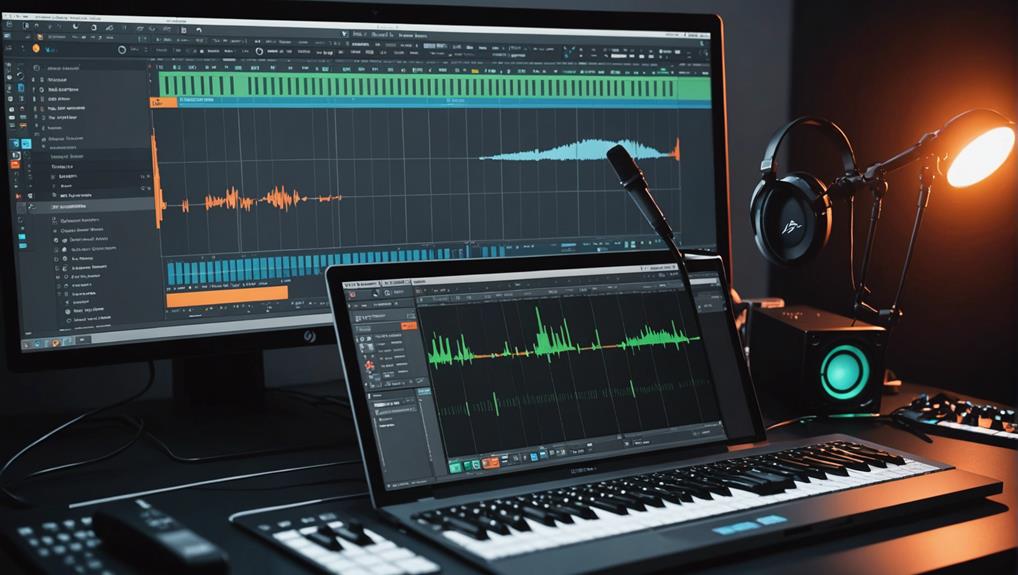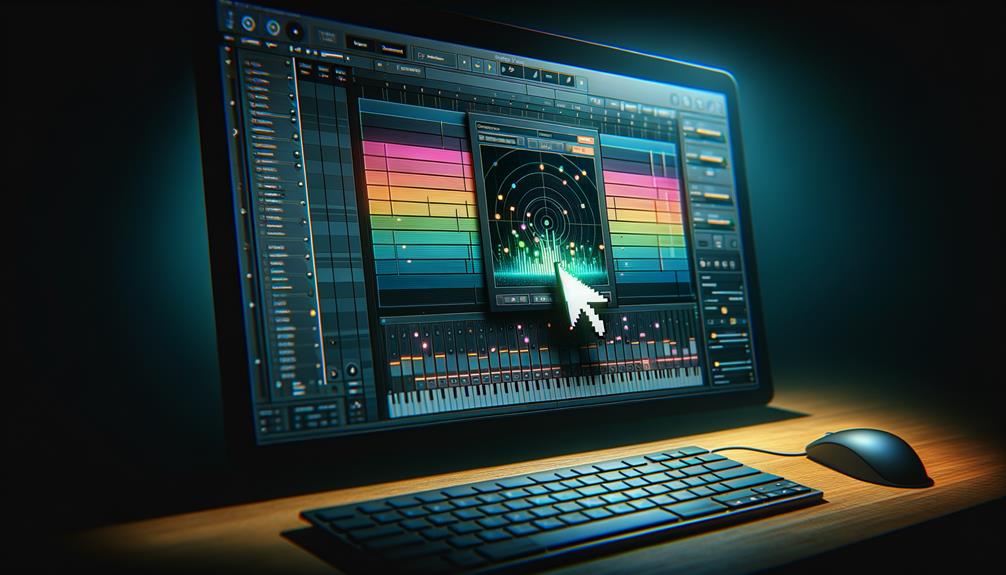To add reverb in FL Studio, start by understanding the different types of reverb to suit your sound. Next, open the Mixer (F9), create a reverb send track, and insert a suitable plugin, such as Reverb 2. Adjust the wet/dry levels for balance, ensuring the dry signal is at 30-50%. Send your audio tracks to the reverb track, and fine-tune the fader levels for cohesion. Finally, experiment with EQ and advanced effects to enhance depth. By mastering these steps, your tracks will gain a rich, atmospheric quality that raises your mix to the next level. Continue exploring for additional techniques.
Key Takeaways
- Open the Mixer in FL Studio by pressing F9 and select an empty insert slot for your reverb send track.
- Insert a reverb plugin like Reverb 2 and adjust the wet/dry balance to achieve the desired effect.
- Route your audio tracks to the reverb send track using send level faders for cohesive application.
- Adjust the fader on the reverb send track to blend the effect with the original sound appropriately.
- Experiment with different reverb types and settings to enhance your mix while preserving clarity and depth.
Understanding Reverb Basics
Reverb, an essential audio effect in music production, simulates the natural reflections that sound waves encounter in various environments, thereby enriching the auditory experience. This effect enhances depth and ambiance, making it a fundamental component across diverse musical genres.
Various types of reverb, including plate, spring, digital, gated, and convolution, offer unique characteristics and applications tailored to specific creative needs. The pioneering use of artificial reverb by Bill Putnam in 1947 marked a significant advancement in audio production techniques, paving the way for further innovations.
The introduction of digital reverb with the EMT 250 in 1976 provided customizable settings, revolutionizing mixing possibilities. Ultimately, reverb remains critical for crafting distinctive soundscapes, particularly in styles like surf music and 1980s pop. Understanding the origins of reverb is crucial for effective music production.
Setting Up Your Mixer
To effectively incorporate reverb into your mix, it is essential to set up your Mixer in FL Studio with precision.
Begin by opening FL Studio and pressing F9 to access the Mixer window. Select the track that contains the sound you wish to enhance with reverb, ensuring it’s clearly labeled for easy identification.
In an empty insert slot, create a dedicated reverb send track to manage the effect independently. Choose a suitable reverb plugin, such as Reverb 2, and insert it into the send track.
Make sure to customize the reverb settings to suit your sound. Additionally, be mindful of frequency masking, as it can affect the clarity of your mix when layering effects like reverb. Finally, play around with the fader on the reverb send track to balance the reverb level, ensuring it complements the original sound without overpowering it.
Creating a Reverb Send Track
To create a reverb send track in FL Studio, begin by selecting an empty insert slot in the mixer and renaming it to something like “Reverb Send” for clarity.
Next, insert a suitable reverb plugin, such as Reverb 2, and configure the wet/dry balance to highlight the reverb effect.
Finally, route the desired audio tracks to this send track using the send level faders, ensuring a cohesive reverb application across multiple elements of your mix. Additionally, consider implementing dual-layering with contrasting reverb types to enhance the depth and richness of your reverb effects.
Setting Up Mixer Track
Creating a dedicated reverb send track in FL Studio is essential for achieving a polished mix, as it allows for effective blending of reverb without compromising the original sound.
To set this up, first route your sound to an available mixer track by selecting the track number in the channel rack. Rename this mixer track to something clear, such as “Reverb Send,” to facilitate easy identification.
Next, select an empty insert in the mixer to create the send track and load a reverb plugin, like Reverb 2. This setup retains the dry signal on the instrument track while applying reverb.
Adjust the send level using the fader on the instrument track, ensuring that low frequencies remain balanced within your mix.
Configuring Reverb Plugin
While configuring the reverb plugin, it is essential to strike a balance between the dry and wet signals to achieve the desired spatial effect without overwhelming the original sound. To create a reverb send track in FL Studio, select an empty mixer insert, rename it to “Reverb Send,” and insert a reverb plugin like Reverb 2. Set the wet signal to 100% while decreasing the dry signal, allowing for versatile reverb applications across multiple audio tracks. By routing desired audio tracks to the send track, you can control reverb automation effectively.
| Setting | Recommendation |
|---|---|
| Dry Signal | Decrease |
| Wet Signal | 100% |
| Reverb Type | Choose as needed |
| Send Volume | Increase as needed |
| Routing Tracks | Select desired tracks |
Choosing a Reverb Plugin
How does one effectively select a reverb plugin in FL Studio to improve their mix?
Begin by considering the reverb types that best suit your sound design needs; for instance, plate reverb can enrich vocals, while spring reverb adds character to guitars and drums.
FL Studio offers built-in options like “Reverb 2,” which features a user-friendly interface for critical adjustments.
However, exploring third-party plugins, such as Valhalla Room and Waves H-Reverb, can boost your mixing quality through advanced algorithms and customization.
Confirm plugin compatibility with your system, and prioritize those that allow for wet/dry mixing to achieve the perfect balance between the original signal and the reverb effect, ultimately enhancing the depth and ambiance of your tracks. Additionally, consider utilizing appropriate reverb type to enhance musical context and spatial effects in your mixes.
Adjusting Wet and Dry Levels
Achieving the perfect balance between wet and dry levels is essential for a polished mix in FL Studio. The wet signal, representing the processed sound with reverb, needs careful manipulation to enhance the track without overwhelming it.
Begin with the dry signal set at approximately 30-50% and the wet signal at 100%, then adjust according to your desired ambiance and clarity. Employ reverb blend techniques by using the mixer fader to control the levels, ensuring effective dry signal preservation. Additionally, maintaining frequency balance is crucial to ensure that the reverb complements rather than muddles your mix.
Regularly tweak these settings while playback to maintain balance, preventing excessive reverb that could clutter the mix. Experimentation is key; the right blend will enhance your sound, elevating the track while retaining its core identity.
Balancing Reverb in the Mix
Balancing reverb in a mix requires precise fader adjustments to control the wet signal’s presence relative to the dry signal, ensuring harmony without overshadowing other elements. Continuous monitoring is essential to maintain clarity, as excessive reverb can lead to a muddied sound. Implementing techniques such as soloing the reverb channel can further refine the balance, allowing for an ideal spatial enhancement that preserves audio definition. Additionally, using high-pass filters can help eliminate unwanted low frequencies, enhancing the overall clarity of the mix.
Fader Adjustment Technique
While mixing, the fader adjustment technique serves as an essential method for achieving the right balance of reverb within a track. By manipulating various fader types on the reverb channel, you can adjust the wet signal relative to the dry signal, guaranteeing the reverb complements rather than overwhelms the original sound.
Begin with a moderate fader adjustment, typically between -6 dB and -12 dB, and fine-tune as necessary to avoid muddiness. Utilizing automation techniques allows for dynamic changes in reverb levels throughout different sections of the track, enhancing sound layering and overall depth.
Regularly evaluate the balance during playback to guarantee the reverb’s presence is appropriate, as perceived levels can shift with varying playback volumes.
Monitoring Reverb Levels
Effective monitoring of reverb levels is essential for ensuring that the effect enhances the overall mix without overpowering the original sound. To achieve this, utilize the mixer fader on the reverb channel, balancing the dry and wet signals during playback.
Start with the wet signal set to 100% for clarity, adjusting the fader on the send track to fine-tune presence. Consider different reverb types and their timing characteristics, as these can influence how the effect interacts with other elements.
Additionally, reverb modulation can introduce dynamic variations, preventing excessive buildup that may muddy the mix. Regularly check levels and apply fader automation for creative adjustments, ensuring a well-balanced and engaging audio experience throughout your track.
Experimenting With Advanced Effects
Exploring advanced effects in FL Studio can greatly improve your mix’s depth and complexity. By integrating creative layering techniques and experimenting with unique reverb types, you can achieve a rich sonic environment.
Consider the following:
- Utilize EQ on the reverb channel to eliminate muddy frequencies.
- Implement automation on reverb levels for dynamic intensity adjustments.
- Test different reverb types like plate or digital for distinctive character.
- Route multiple tracks to a single reverb insert for cohesion.
- Enhance creativity by incorporating advanced modulation effects, delay, or distortion.
- Understanding the different types of reverb can help you choose the right effect for your mix.
These strategies not only refine your mix but also invite unexpected textures and depth, resulting in a more engaging listening experience.
Take the time to explore these options, and improve your productions to new heights.
Frequently Asked Questions
How Do I Add Reverb in FL Studio?
To add reverb in FL Studio, explore various reverb types using diverse plugin options. Employ effective mixing techniques, adjusting wet and dry signals, while incorporating EQ to refine clarity and enhance overall sound quality in your mix.
How Do I Add Reverb to a Kick in FL Studio?
To effectively apply kick reverb techniques, utilize a dedicated mixer insert, adjust wet and dry signals for creative effects, and implement mixing tips to maintain clarity, ensuring the kick’s prominence without overwhelming muddiness.
How to Add Reverb to Audio?
To effectively add reverb to audio, consider a reverb types comparison, selecting appropriate reverb plugin recommendations like Valhalla Room. Employ mixing reverb tips, such as adjusting wet/dry ratios, to achieve a balanced, immersive sound.
Can You Automate Reverb in FL Studio?
Yes, you can automate reverb settings in FL Studio. Utilize automation clips for creative techniques, enabling dynamic adjustments to parameters like wet level and decay time, enhancing the overall sound and emotional impact of your mix.
Conclusion
Incorporating reverb into a mix enhances the spatial quality of audio, contributing to a more immersive listening experience. By understanding the fundamental principles of reverb, setting up the mixer appropriately, and utilizing a dedicated reverb send track, artists can achieve ideal results. Selecting the right plugin and carefully adjusting wet and dry levels are essential for achieving balance. Furthermore, experimenting with advanced effects can further enrich the mix, ultimately leading to a polished and professional sound.



